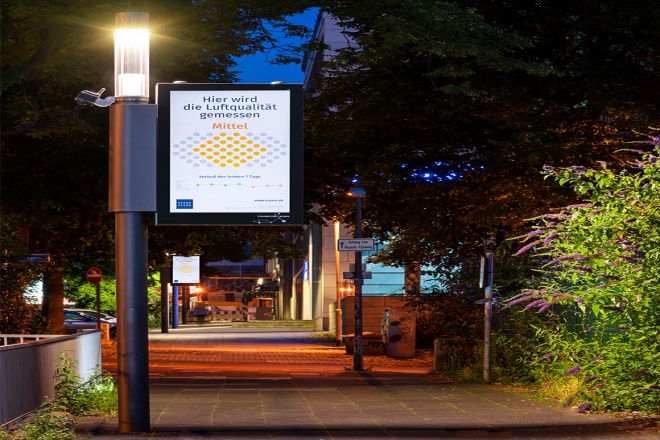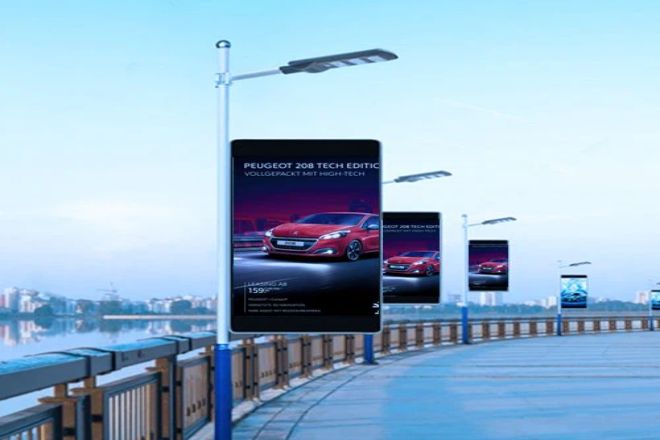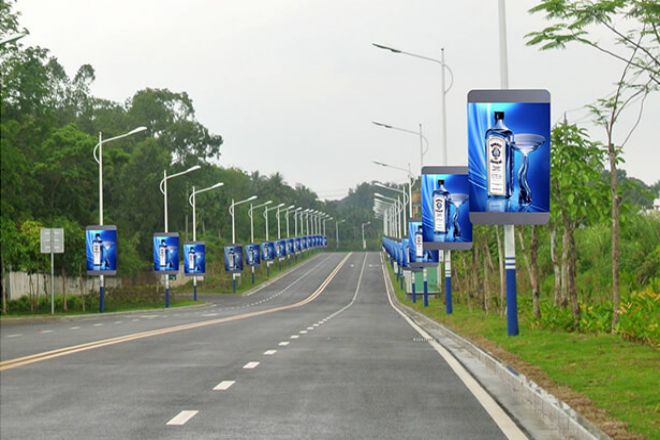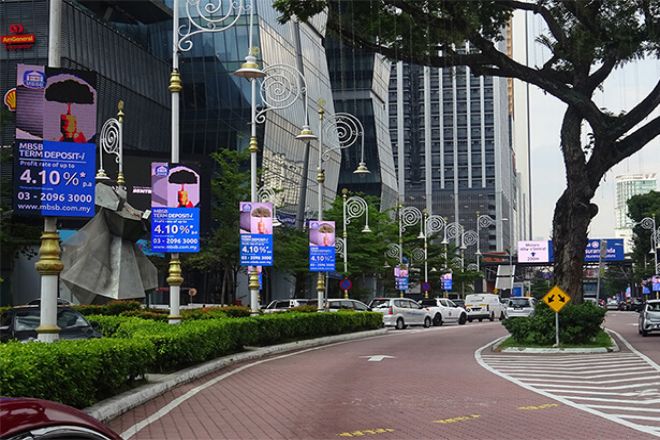Introduction

With the continuous advancement of science and technology, LED display screens have gradually become an important carrier of the urban landscape and advertising with their unique advantages.
Among them, pole LED displays have attracted more and more people’s attention and love due to their easy installation, convenient maintenance, and flexible application. This article will introduce in detail the common knowledge of light pole LED displays to help you better understand and apply this product.
1. The composition and structure of the pole LED display
As an important tool for modern urban advertising and information release, the design of the pole LED display directly affects its display effect and service life.
1). Display panel
The display panel is the core part of pole LED display. Its material, size, and pixel density directly determine the display effect.
Material: Common display panel materials include glass, acrylic, etc. Glass panels have high light transmittance and flatness and can present clearer images, while acrylic panels have lighter weight and good weather resistance, making them suitable for outdoor environments.
Size: The size of the display panel can be customized according to actual needs. Common sizes are 1 meter × 2 meters, 2 meters × 3 meters, etc. The larger the size, the larger the displayed screen and the more stunning the visual effect.
Pixel density: Pixel density refers to the number of pixels per unit area, which determines the detail and clarity of the picture. The higher the pixel density, the clearer the picture and the richer the details.
2). LED lamp beads
LED lamp beads are the basic unit of the display panel. Their type, brightness, and color performance directly affect the overall effect of the display screen.
Type: According to the purpose and luminous characteristics, LED lamp beads can be divided into various types, such as single color, double color, and full color. Single-color LED lamp beads can only emit a single color of light, such as red, green, etc.; two-color LED lamp beads can emit two colors of light, such as red and green; and full-color LED lamp beads can emit light of multiple colors. , achieving richer color expression.
Brightness: The brightness of LED lamp beads is an important indicator of their luminous ability. The higher the brightness, the brighter the picture and the better the visual effect. However, too high brightness may also lead to increased energy consumption and light pollution problems, so a reasonable selection needs to be made based on the actual scene.
Color performance: Color performance refers to the color range and brightness that LED lamp beads can present when displaying pictures. High-quality LED lamp beads have a wider color gamut and higher color reproduction and can present a more realistic and vivid picture.
3). Drive and control system
The drive and control system is a key part of the LED display on the light pole. It is responsible for converting the video signal into the lighting and color changes of the LED lamp beads to achieve the display of the picture.
Function: The main functions of the drive and control system include signal reception, image processing, brightness adjustment, color correction, etc. It can receive video signals from the outside, process them, and transmit them to the display panel to achieve a normal display of the picture.
Features: The drive and control system has the characteristics of high stability, fast response speed, and rich functions. It can adapt to various complex environmental conditions and video signal formats to ensure stable operation and high-quality display of the display.
Stability: In order to ensure the long-term stable operation of pole LED display, the drive and control system needs to have high stability. This includes requirements such as strong anti-interference ability, low failure rate, and convenient maintenance.
2. Light pole and installation structure

The light pole and installation structure are the supporting and fixing components of the light pole LED display. Its design, material, and load-bearing capacity are crucial to the safety and stability of the display.
- Design
The design of the light pole and installation structure not only affects the appearance of the display but also affects its performance and safety. Light poles usually adopt a cylindrical or conical design with a simple and elegant appearance, which meets the aesthetic needs of modern urban landscapes.
The design of the installation structure is customized according to the specific size and weight of the display to ensure stability and safety after installation. At the same time, the design also needs to take into account the convenience of installation and maintenance to facilitate future operation and management.
- Material
The material selection of the light pole and installation structure is directly related to its service life and safety, as well as its safety. Common materials include steel, aluminum alloy, and other metal materials.
Steel materials have high strength and load-bearing capacity and are suitable for the installation of large displays; aluminum alloy materials have lighter weight and good corrosion resistance and are suitable for outdoor environments. When selecting materials, factors such as cost, processing difficulty, and environmental protection also need to be considered.
- Load Capacity
Load-bearing capacity is an important indicator for measuring the performance of light poles and installation structures. It requires reasonable calculation and design based on factors such as the size and weight of the display and the wind load of the installation location.
During the design process, the impact of various extreme weather conditions needs to be fully considered to ensure the safety and stability of the display screen under various harsh weather conditions. At the same time, the test of load-bearing capacity is also an essential link, and the rationality and reliability of the design can be verified through actual testing.
3. Selection and installation of pole LED display
The selection and installation of lpole LED displays is a complex process involving many factors, which are directly related to the use effect, safety, and stability of the display. These two key steps are discussed in detail below.
- Selection
Choose the appropriate model and specifications according to the application scenario. First, clarify the purpose and scenario of the display screen. For example, is it for city advertising or as part of the cityscape? Is it used in a densely populated commercial area or a quieter residential area? Different usage scenarios have different specifications and display performance requirements.
If it is used for advertising, you need to consider factors such as foot traffic and target customers and choose a high-brightness, high-definition display to attract the attention of pedestrians.
If it is used for the urban landscape, factors such as urban planning and aesthetics need to be considered, and a display screen that is coordinated with the surrounding environment needs to be selected to enhance the image of the city.
Consider your budget: Display prices vary based on model, specifications, brand, and more. When selecting, you need to make a reasonable choice based on your budget to ensure the best display effect and performance within the budget.
- Installation
Consider the installation environment and light pole structure: The installation environment is crucial to the stability and safety of the display. Before installation, it is necessary to conduct an on-site inspection of the installation environment to understand the flatness of the ground, load-bearing capacity, wind force, and other factors. At the same time, the structure and height of the light pole also need to be considered to ensure that the display screen can be firmly installed on the light pole.
Follow installation specifications and precautions: During the installation process, relevant installation specifications and precautions must be followed to ensure installation quality and safety.
Before installation, you should carefully read the product manual and installation drawings to understand the installation steps and precautions.
Professional installation tools and equipment need to be used to ensure stability and safety.
After the installation is completed, comprehensive inspection and testing are required to ensure that the display screen can work properly and achieve the expected display effect.
In addition, you also need to pay attention to the following points:
Ensure that the connection between the display screen and the light pole is firm and reliable to prevent shaking or falling off due to wind or other external factors.
Install heat dissipation equipment on the back and sides of the display to ensure that the display can maintain good heat dissipation performance during operation and prevent overheating from affecting the use effect and lifespan.
The installation height and angle of the display screen also need to be adjusted according to the actual situation to ensure that pedestrians or spectators can view the content of the display screen from the best angle.
4. What is the brightness of the pole LED display?

The brightness of the pole LED display is an important performance parameter that directly affects the visual effect of the display in outdoor or indoor environments. Generally, outdoor LED displays have relatively high brightness requirements to ensure that content can be displayed clearly under various light conditions. The brightness of indoor LED displays is relatively low to adapt to the light conditions of the indoor environment.
Specifically, the brightness of outdoor pole LED displays is usually greater than 8000mcd/㎡, which is an important reason why it can be used outdoors all day long. The brightness of indoor LED displays is greater than 2000mcd/㎡. This brightness is designed to ensure that the display can present clear, vivid images and video content whether it is day or night, sunny or cloudy.
It should be noted that the brightness of the LED display is not as high as possible. Excessive brightness may cause glare or discomfort to viewers and may even cause damage to vision. Therefore, when selecting a model, the appropriate brightness should be selected based on the actual use environment and needs.
In addition to brightness, other performance parameters of pole LED displays, such as resolution, contrast, viewing angle, etc., also need to be considered when selecting. At the same time, the installation environment and light pole structure are also important factors affecting the use effect of the display screen, which require full consideration and reasonable planning during the installation process.
5. How do you make a pole LED display resistant to high temperatures?
The high-temperature resistance of the pole LED display mainly depends on its unique design and material selection.
First of all, from a design perspective, the appearance design and internal structure of the pole LED display have been adjusted to optimize the heat dissipation effect. For example, circuit boards with hollow designs and high-density and high-precision designs help dissipate heat.
At the same time, the interior uses a macro-permeable design, which not only avoids the risk of rain accumulation and wire short circuits but also further improves heat dissipation efficiency. In addition, the display screen does not have a fan, which reduces the load on the LED circuit and achieves efficient heat dissipation by combining the inside and outside.
Secondly, the choice of material also plays a key role in high-temperature resistance. The box of the pole LED display is usually made of die-cast alloy. This material not only has high strength but also has good high-temperature resistance.
At the same time, the surface of the LED display module is designed in black. This black mask helps absorb and dissipate heat, further improving the high-temperature resistance of the display.
In addition, in order to cope with high-temperature environments, the pole LED display also adopts a waterproof design to ensure that it can work normally in humid or rainy environments. This waterproof design not only protects the electronic components inside the display but also helps prevent heat dissipation issues caused by excessive humidity.
6. Maintenance and maintenance of pole LED display

The maintenance and upkeep of the pole LED display is the key to ensuring its long-term stable operation and extending its service life. The following are detailed suggestions for the maintenance and maintenance of pole LED display:
- Regular inspection and cleaning
Regularly check the working status of the display, including brightness, color, clarity, etc., to ensure that the display effect is good.
Conduct a comprehensive inspection at least once a month, including the surface of the display, internal structure, power supply, signal lines, etc., to discover and solve potential problems in a timely manner.
Clean the display surface regularly to remove dust and dirt and keep the display clean and beautiful. When cleaning, use a soft dry cloth or anti-static soft-bristled brush, and avoid direct rinsing with chemical detergents or water.
- Waterproof, dustproof, and lightning protection measures
For LED displays on light poles used outdoors, waterproof and dustproof measures should be taken, such as installing a waterproof cover or a waterproof-designed box, to ensure that the display can work normally even in bad weather.
Regularly check whether the waterproof and dustproof facilities of the display are intact. If there is any damage, replace or repair it in time.
In lightning-prone areas, lightning rods and lightning protection equipment should be installed to ensure the safety of the display during lightning weather.
- Heat dissipation and temperature control
The display generates heat when working, and poor heat dissipation can lead to performance degradation or even damage. Therefore, you should ensure that the display’s cooling system, such as fans, heat sinks, etc., is working properly.
Regularly check the working status of the cooling system. If there is any blockage or damage, it should be cleaned or replaced in time.
In high-temperature environments, measures such as reducing the brightness of the display and adding heat dissipation equipment can be taken to control the temperature of the display.
- Troubleshooting and maintenance
Once the display fails, it should be checked and repaired in time. Common faults include power failure, signal failure, display failure, etc.
For power failure, check whether the power cord is loose or damaged and whether the power plug is in good contact.
For signal failures, check whether the signal cable is connected correctly and whether the signal source is normal.
For display faults, such as black screen, blurred screen, etc., you should check whether the driver board, control board, and other components of the display screen are normal.
Conclusion
Through the introduction of this article, I believe you will have a more comprehensive and in-depth understanding of the common knowledge of pole LED displays.
In future applications, we should give full play to their advantages and characteristics, rationally select and install them, and pay attention to maintenance and upkeep to achieve better application effects and economic benefits.
Finally, if you are interested in a pole LED display, please get in touch with us.
